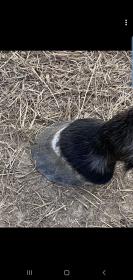Hi,
I am new here and while I have owned horses before, it’s been 20 years since I have bought a horse. I have two questions:
-
The horse we are very interested in has a crack in each front hoof (he is barefoot). The crack is about 1/2". How would this impact your purchase decisions? Would it be a deal-breaker, would you negotiate the price down to cover the cost of the farrier working on the crack?
-
Quarantine: I see some posts about quarantining new horses, but that was in a kill-rescue thread. We will be getting 2-3 horses and have none right now although we ride at a nearby stable. If the horses are coming with vet exams, negative coggins, etc, would you still quarantine each new horse for a month? We are doing natural boarding and so our set up is a run-in shed in our pasture with the double fence around the perimeter to encourage movement around the whole pasture. We have a second pasture cross fenced, and a shelter in that - there is a common narrow fence separating the two pastures but we could add a strip of electric fence to keep them apart. Even if not quarantining, would you start the second horse in the other pasture so they’d have that separation for introduction or if they are all relatively new to the property would you add them into the same pasture?
Thanks,
Shannon



